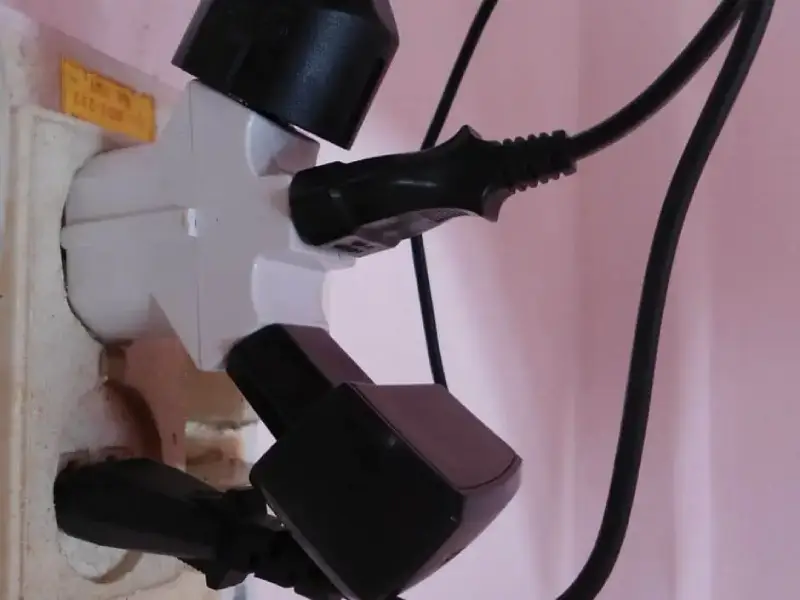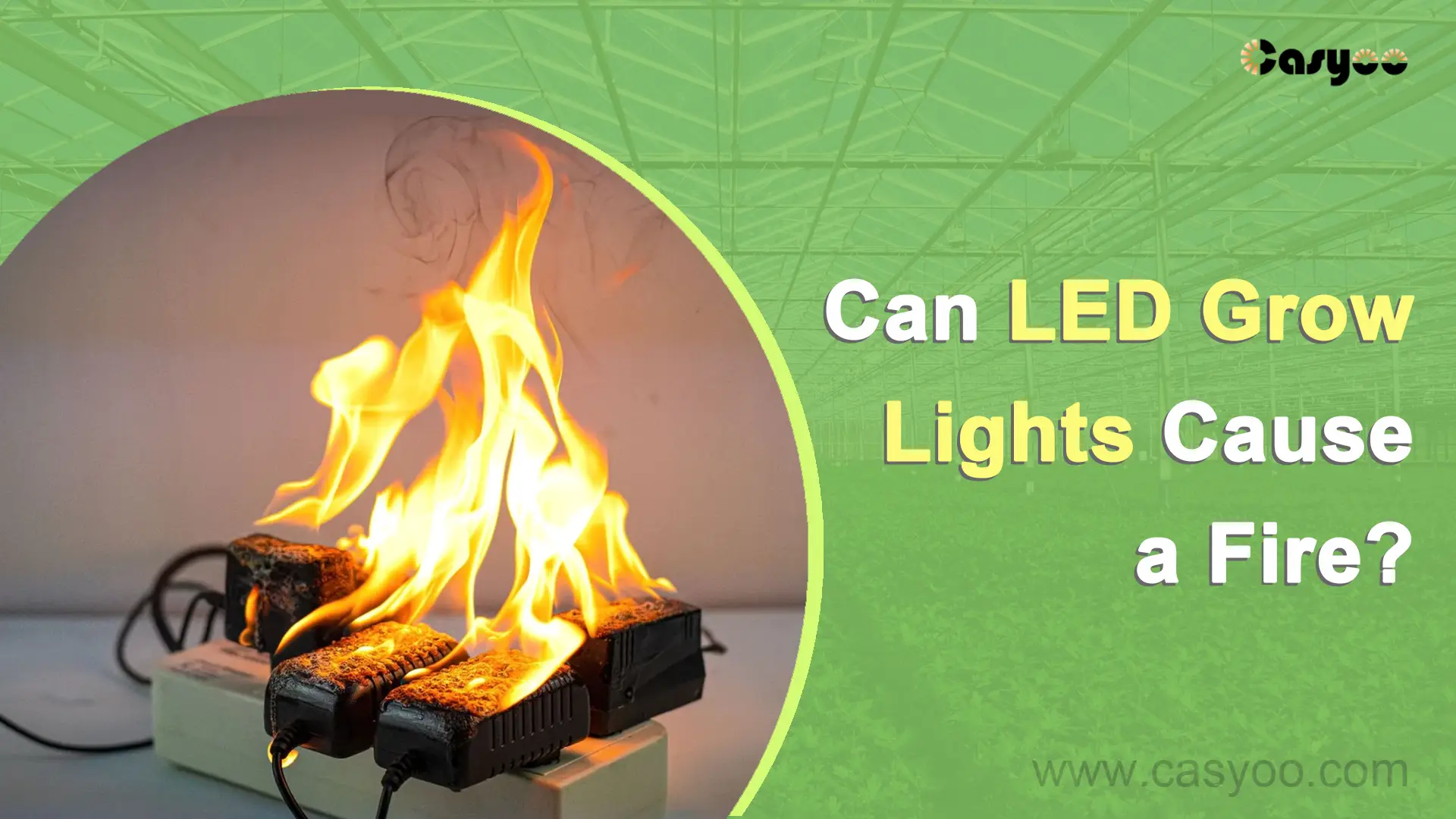Grow lights produce a significant amount of heat which has the potential to cause a fire if not installed and handled correctly. Traditional grow lights, such as HID lights, are more likely to cause a fire than LEDs. Equipped with state-of-the-art LED technology, LED grow lights emit less heat. While they may not get hot enough to directly ignite a fire, they can still become a fire hazard if not properly installed.
Though the risk is not high, you still need to take precautions to reduce the chance of a fire. Keep reading to learn more.
When Do LED Grow Lights Become a Fire Hazard?
1. Poorly Made LED Lights
Poorly made LED grow lights often have inferior parts or insufficient insulation, which increases the risk of electrical malfunctions and fire.
2. Overheating due to Incorrect Installation
Heat accumulation can result from incorrect installation of LED lights, which includes inadequate ventilation systems or positioning them too near flammable objects.
3. Electrical Problems and Defective Wiring
Unsecured connections, poor electrical insulation, or defective wiring can lead to short circuits and overheating. If these electrical problems are not addressed promptly, LED lights may catch fire.
4. Voltage Fluctuations or an Insufficient Power Supply
These issues can cause LED grow lights to malfunction, overheat, and even catch fire.
5. Overloaded Electrical Circuits

This can happen when too many lights are connected to a single circuit.
6. Lack of Routine Maintenance
Ignoring routine maintenance can hinder heat dissipation and increase the risk of fire.
7. Improper Electrical Wiring
Improper electrical wiring can short-circuit and start a fire. Typical wiring mistakes made by people include the following:
- Not Using a Junction Box
The junction box, also known as an electrical box, guards the hub of all the wiring in a circuit. You should ask an electrician to mount a junction box to the wall or other fire-resistant material.
- Wires That Are Too Short
Make sure the length of wire for your LED grow lights is sufficient. If you cut them too short, they could become stretched and finally shatter.
- Unprotected Wires
Keep in mind that exposed wiring frequently breaks and can start a fire. Clamps can be used to maintain them straight and tightly. To put it briefly, your goal should be to keep the wire safely above the ground.
- Incorrect Wattage and Amperage
Ensure that your grow room’s wiring can support the wattage of your LED grow lights. You will need to rewire the entire grow room if the wiring is outdated.
8. Defects in Heat Dissipation System Design
Generally speaking, LED grow lights often use heat sinks together with fans to dissipate heat. Common system design defects include:
- Insufficient heat sink area: The heat sink dissipates heat by acting as an extension of the LED chip. For high-power LED chips, if the heat sink is too small, the heat dissipation efficiency will be too low.
- Improper heat sink material: The heat sink should be built from a thermally conductive material like aluminum or copper. If it is made from materials with poor thermal conductivity, the heat dissipation performance will suffer.
- No fan or insufficient fan: High-power LED lights often need both a heat sink and a fan to properly dissipate heat.
- Unreasonable heat dissipation path design: If the heat transfer path from the LED chip to the heat sink or fan is too long, the heat cannot be effectively dissipated. Some heat dissipation paths fail to disperse the heat evenly, which will cause overheating in certain areas.
Will Leaving LED Lights on 24/7 Cause a Fire?
Most high-quality LED plant lights can run for long periods, and some can even be left on 24/7. However, most plants do not need 24 hours of light. They require a period of darkness to complete physiological activities other than photosynthesis. If the light duration is too long, it may cause abnormal plant growth or leaf damage. Most plants need 12–18 hours of light each day.
In addition, even though high-quality LED plant lights support long-term operation, leaving them on 24/7 may cause overheating. This can be especially risky if the LED plant light is in an environment that is not conducive to heat dissipation and ventilation, or is already at a high temperature. If you are using low-quality LED lamps or there are existing problems with the circuit or power supply, the lights may catch fire. Therefore, it is not advisable to leave a LED grow light on 24/7.
How to Prevent LED Grow Lights from Causing a Fire?
Use High-Quality LED Grow Lights
While it may seem enticing to save a few bucks for a poorly-made LED, you should be aware that the savings are probably insufficient to repair the damage a fire does if something goes wrong. Below are some key points you should look for:
- Be sure to choose certified lights to ensure safety. Certifications like CE for the EU market, UL and ETL for the North American market all have evaluations of the heat generation and dissipation performance of lamps. For example, UL certification includes lamp surface temperature testing, heat dissipation component qualification testing, etc., to ensure that the lamp will not cause a fire.
-
Fire-resistant LED driver: Make sure that the LED driver you choose has the overvoltage and overcurrent protection. Such protection not only guards against input voltage variations, but keeps current constant and avoids capacitor explosion, arcing of PCB traces, and thermal instability.
-
Good heat sink material: Most LED lamps on the market are designed using aluminum alloy as the material for the heat sink because it is a cost-effective material. Though its thermal conductivity is not as good as copper, it is not bad (150-200 W/mK), and it is lighter and less expensive than copper, so it can be used in most LED lamps.
-
Heat dissipation design: Extruded fin heat sinks are the best because using them increases the surface area by 40 percent over stamped designs. If you’re worried about heat dissipation in very high-power LED lamps, look for more efficient cooling methods such as heat pipes and liquid cooling.
Ensure the Electrical Wiring Is Safe
Unless you are a licensed electrician, you should ask for help if you need to wire your lights to make sure there are no problems.
Cutting cables too short, leaving bare wire exposed, and neglecting to keep electrical outlets away from moisture are common blunders that might raise the fire risk.
Do Not Overload The Electrical Circuit
Make sure your electrical system can support the lights you plan to purchase.
Make sure the voltage needs of the grow lights and the voltage of your electrical outlets are compatible.
Additionally, try not to plug too many lights into one socket. It is not a good idea to daisy-chain several extension cables together so that multiple gadgets are powered by a single wall socket.
Make Sure the Safety of Your Growing Space’s Overall Environment
There should be no combustible materials of any kind, such as paper and fabric in the grow room.
Ensure that your planting area is away from the living area. Get rid of anything that can cause a fire before installing grow lights. This is not only important to prevent fire but also to reduce the negative effects of grow lights on you to a minimum.
Remember that hydroelectric contact results from any contact between electricity and water. It can result in electrocution in addition to causing a short circuit. Make sure your LED grow lights stay away from the water.
How to Prevent LED Grow Lights from Overheating in High-Temperature and High-Humidity Environments?

- Choose LED grow lights with:
- Efficient heat sinks and active cooling fans
- At least an IP65 rating to prevent moisture and water vapor
- Enhance environmental ventilation and heat dissipation
- Install exhaust fans or circulation fans near the lamps.
- Install vents to ensure good air circulation throughout the grow space.
- Optimize the installation of lamps
- Maintain sufficient spacing between multiple lamps to avoid heat accumulation. The spacing between lamps should be at least 20-30 cm.
- Avoid obstacles above the lights that could block heat dissipation, such as closed ceilings or low ceilings.
- Regular maintenance and monitoring
- Regularly clean dust from heat sinks and fans.
- Regularly check that the waterproof seals on the lights are intact, and replace any seals that are aging or damaged.
- Monitor the operating temperature of the lights with temperature sensors to detect overheating in a timely manner.
Final Thoughts
The possibility of an electrical fire exists with all electrical devices, so LED grow lights carry a fire risk. However, this risk can be significantly reduced by purchasing from a reliable manufacturer that uses high-quality components. In addition, make sure the lights are hung a sufficient distance from any flammable objects. Ideally, there should be no combustible objects in your grow area, but if there are, they should be kept far away from your grow lights.
Casyoo insists on using products with multiple certifications such as UL and that have undergone heat dissipation-related tests such as life tests, accelerated aging tests, and thermal cycle tests, and is committed to providing customers with the safest lamps. Contact us to learn about our safe LED grow lights!




